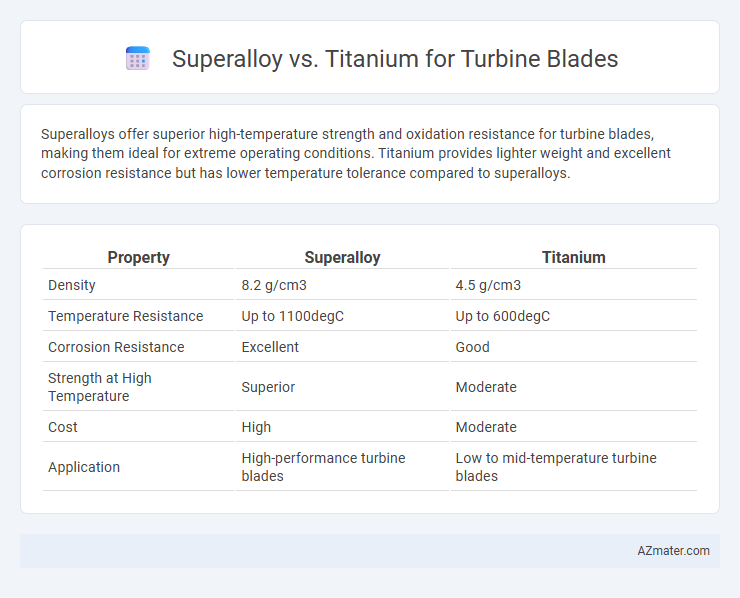Superalloys offer superior high-temperature strength and oxidation resistance for turbine blades, making them ideal for extreme operating conditions. Titanium provides lighter weight and excellent corrosion resistance but has lower temperature tolerance compared to superalloys.
Table of Comparison
| Property | Superalloy | Titanium |
|---|---|---|
| Density | 8.2 g/cm3 | 4.5 g/cm3 |
| Temperature Resistance | Up to 1100degC | Up to 600degC |
| Corrosion Resistance | Excellent | Good |
| Strength at High Temperature | Superior | Moderate |
| Cost | High | Moderate |
| Application | High-performance turbine blades | Low to mid-temperature turbine blades |
Introduction to Turbine Blade Materials
Superalloys and titanium alloys are the primary materials used for turbine blades due to their exceptional strength and temperature resistance. Superalloys, based on nickel or cobalt, offer superior high-temperature performance and oxidation resistance, making them ideal for the hottest sections of turbine engines. Titanium alloys provide an excellent strength-to-weight ratio and corrosion resistance, suitable for cooler sections where lighter components improve overall engine efficiency.
Overview of Superalloys
Superalloys, primarily composed of nickel, cobalt, or iron, are engineered for exceptional strength, corrosion resistance, and heat tolerance, making them ideal for turbine blade applications. Their ability to maintain mechanical properties at temperatures exceeding 1000degC ensures optimal performance in high-stress environments within jet engines and power plants. Compared to titanium, superalloys offer superior creep resistance and oxidation stability, critical for extending turbine blade lifespan and reliability under extreme operating conditions.
Titanium Alloys: Properties and Applications
Titanium alloys exhibit exceptional strength-to-weight ratios, corrosion resistance, and high-temperature performance, making them ideal for turbine blade applications where weight reduction and durability are critical. Their high melting points and excellent fatigue resistance enable turbine blades to withstand extreme operational stresses and thermal cycling better than conventional materials. Applications in aerospace and power generation benefit from titanium alloys' ability to maintain structural integrity while improving engine efficiency and lifespan.
Mechanical Strength Comparison
Superalloys exhibit superior mechanical strength at high temperatures, making them ideal for turbine blade applications operating under extreme thermal and stress conditions. Titanium alloys offer excellent strength-to-weight ratios but generally have lower creep resistance and tensile strength at elevated temperatures compared to superalloys. The choice between superalloy and titanium for turbine blades depends on operating temperature requirements, with superalloys preferred for high-temperature environments and titanium favored for lower-temperature, lightweight applications.
High-Temperature Performance
Superalloys exhibit superior high-temperature strength and oxidation resistance compared to titanium, making them ideal for turbine blades exposed to extreme thermal environments above 1000degC. Titanium alloys offer excellent strength-to-weight ratios but degrade rapidly when exposed to temperatures exceeding 600degC, limiting their use in hot section turbine components. Advanced cooling techniques and thermal barrier coatings further enhance superalloy performance, sustaining mechanical integrity under prolonged high-temperature operation.
Corrosion and Oxidation Resistance
Superalloys exhibit superior corrosion and oxidation resistance at high temperatures due to their complex compositions rich in elements like chromium, cobalt, and aluminum forming protective oxide layers. Titanium alloys, while lightweight and strong, are more susceptible to oxidation and require protective coatings or controlled environments to maintain performance in turbine blade applications. The enhanced durability of superalloys under extreme thermal and oxidative stress makes them the preferred choice for turbine blades in harsh combustion environments.
Manufacturing and Cost Considerations
Superalloy turbine blades require complex casting processes such as directional solidification and single-crystal growth, significantly increasing manufacturing time and cost compared to titanium blades, which benefit from advanced machining and additive manufacturing techniques. Titanium, while lighter and easier to machine, demands precise control during fabrication to prevent contamination and maintain mechanical properties, influencing overall production expenses. Cost analysis reveals superalloys incur higher raw material and processing expenses due to their alloying elements and heat treatment requirements, whereas titanium offers savings through reduced weight and simpler manufacturing, making it a cost-effective choice for specific turbine applications.
Weight and Efficiency Factors
Titanium offers significant weight reduction compared to superalloys, enhancing turbine blade performance through lower centrifugal stress and improved fuel efficiency. Superalloys, with higher temperature resistance, maintain structural integrity in extreme heat, crucial for efficiency in high-performance turbines. Selecting titanium or superalloy for turbine blades hinges on balancing weight savings against thermal durability requirements to optimize overall engine efficiency.
Typical Use Cases in Turbine Blades
Superalloys dominate high-pressure turbine blades in jet engines due to their exceptional creep resistance and ability to maintain strength at temperatures above 1000degC, essential for withstanding extreme thermal and mechanical stresses. Titanium alloys are primarily used in low-pressure turbine blades where temperatures are lower, typically below 600degC, benefiting from titanium's high strength-to-weight ratio and corrosion resistance, which improve fuel efficiency without compromising durability. The choice between superalloy and titanium hinges on operating temperature thresholds and performance requirements, with superalloys preferred for the hottest sections and titanium for areas demanding lighter components.
Choosing the Optimal Material: Superalloy vs Titanium
Superalloys offer exceptional high-temperature strength and oxidation resistance, making them ideal for turbine blades operating in extreme thermal environments. Titanium provides superior strength-to-weight ratio and excellent corrosion resistance but lacks the elevated temperature capabilities of superalloys. Selecting the optimal material depends on specific engine conditions, balancing performance requirements with cost-effectiveness and durability under operational stresses.

Infographic: Superalloy vs Titanium for Turbine Blade
 azmater.com
azmater.com